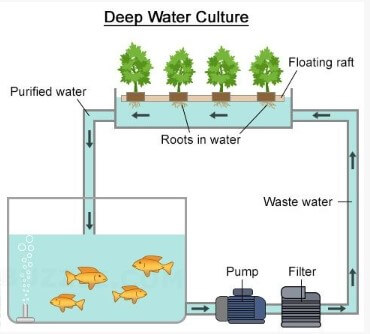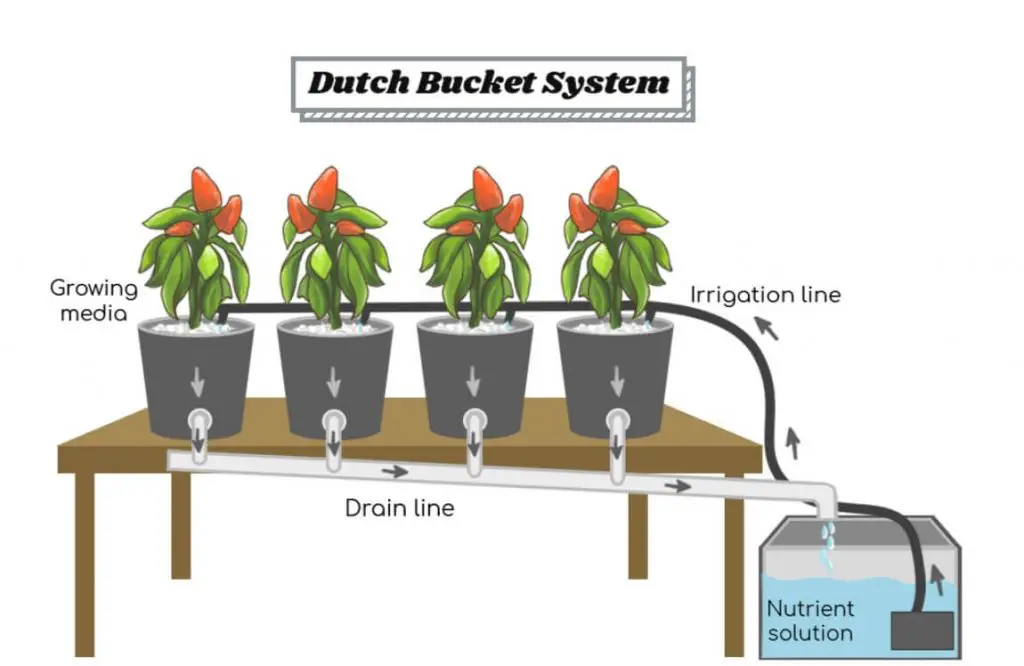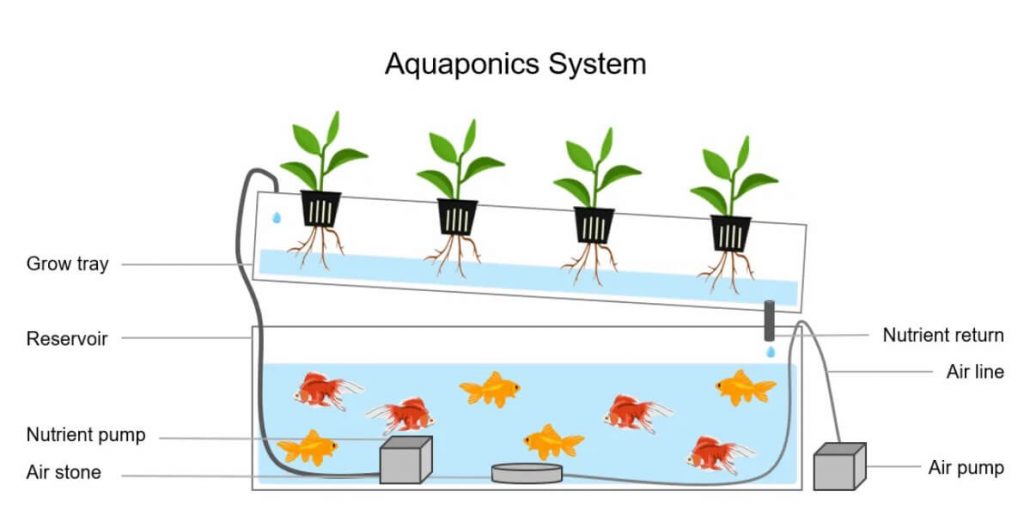Aquaponic Tomatoes: How To Grow, Common Issues + Best Varieties [2022]
Aquaponic tomatoes are a great way to grow your own produce and have control over the quality and pesticides used.
In an aquaponics system, the tomato plants grow in continuously circulated and filtered water.
This system uses nitrifying bacteria to convert ammonia from fish waste into nitrates, which are then used by plants as fertilizer.
The result is healthy, organic tomatoes without any of the drawbacks of traditional soil-based gardening.
Read on for the full guide.
Summary
1. A Guide To Aquaponic Tomatoes
2. Key Steps In Growing Aquaponic Tomatoes
3. What Is Aquaponics
4. How Long Aquaponic Tomatoes Grow?
5. Issues With Growing Tomatoes In Aquaponics
6. Factors To Consider For Growing Tomatoes In Aquaponics
7. Best Tomato Varieties For Aquaponics

Affiliate Link Disclosure
Some of the links on here are affiliate links and I may earn if you click on them, AT NO EXTRA cost to you. Hope you find the information here useful! Thanks.
Related Posts
- How Cold Can Tomatoes Tolerate?[+Tips To Keep Them Juicy]
- Can Tomatoes Grow In Clay Soil?
- 13 Disease Resistant Tomatoes Types Worth Growing In 2022
- How To Grow Moneymaker Tomatoes +Tips To Grow Faster! [2022]
- How To Grow Oxheart Tomatoes+ Unique Growing Tips [2022]
A Guide To Aquaponic Tomatoes
These are the three methods on how to grow tomatoes in aquaponics:
- Conventional Gravel Bed Method
- Deep Water Culture (DWC) Method
- Dutch Bucket Aquaponic Tomatoes
1. Conventional Gravel Bed Method

In the first method, tomatoes must be planted in a grow bed that is full of growing medium (a growing medium is a substance that allows plants to grow their roots and thrive)
Make sure the gravel does not include any limestone as limestone can raise the pH level above what is ideal, which will hurt your aquaponic tomatoes.
2. Deep Water Culture (DWC) Method

With this method, you will need to locate or construct a container to allow water to be pumped from the fish tank into it.
You’ll effectively be making a canal by doing this.
Next, you should make a growth medium for the tomatoes above it. This can look like the shape of a pot lid with holes drilled into it.
The pot should then be slightly submerged in water and filled with gravel or your preferred media. This will prevent the roots of the tomatoes from becoming soaked while they acquire the water they need.
Last but not least, make sure the water in the Deep Water Culture system is consistently thoroughly aerated.
3. Dutch Bucket Aquaponic Tomatoes

This system makes use of buckets that are connected to your fish tank.
You can arrange several buckets in a row and connect them all to the fish tank with a single central connection.
This is filled with water, which is then pumped through it and into each bucket before being allowed to drain back into the fish tank for another cycle.
Your growing medium will be in the bucket, which preferably has a lid with a hole wide enough for the tomato plant to come out.
Additionally, you can add some dry media on top to stop the growth of algae.
As the water seeps through the growing medium, microorganisms turn the ammonia in the gas into nitrates, which feed the plants.
This system is excellent for preventing system interference from plant roots. It is simple to keep these roots contained if you only plant one thing in each container.
Key Steps In Growing Aquaponic Tomatoes
After choosing the system that you would like to work with, keep these key steps in mind when growing aquaponic tomatoes.
1. Check the pH of the water to make sure it is between 5.8 and 6.8.
By adding a fish-safe pH stabilizer, you may adjust the pH up or down to the right amount.

2. Rinse the growing medium to get rid of any dust or other contaminants that could affect the pH of the water. Add the medium to the growing container until it is about one-third full.
3. The tomato seedlings should be taken out of their containers, and the soil should be gently washed off the roots with water. Take care to avoid breaking or damaging the roots.
4. Spread out the roots of the seedlings and carefully add more growing material to cover at least 2 inches of the stem before placing them in the aquaponic growing container. This will ensure that the plant is stable and erect.
5. Red wiggler worms can assist minimize the growth of algae, try to add those in as well. Add organic matter that is good for fish and plant growth.
6. To maintain the pH at the proper level, check the pH every day for the first month of growth and then once a week after that. Low pH may indicate low phosphorus levels. As necessary, make adjustments using a stabilizer safe for fish.
7. On tomato plants, aphids, a tiny bug that resembles lice, should be kept an eye out for.
8. To keep pests at bay, spray the leaves with a natural solution made of equal parts water and home vinegar.
FAQs:
What Are Aquaponics?

Aquaponics is a growing technique involving both fish and a plant-growing container. Water containing nutrients is delivered via a tube from a fish tank toward the tomato plant. There are several sizes of aquaponic systems, ranging from tiny hobby gardens up to large-scale businesses.
Tomatoes grow best in fish water because it contains the correct amount of minerals for fruit formation.
How Long Aquaponic Tomatoes Grow?
Aquaponic tomatoes indoors can achieve their maximum size in just 4 weeks.
The quickest tomatoes to grow in aquaponic systems are cherry tomatoes, which can begin blossoming in as little as one month in some scenarios.
They can be harvested as soon as one and a half months, at most two.
Larger species, like beefsteak tomatoes, might need an extra week or two before they start to bloom.
They could potentially take up to two or three additional weeks to fully ripen.
Issues With Growing Tomatoes In Aquaponics
- Root rot
- Lack of nutrients, water, or oxygen
- Powdery mildew
- Drooping leaves
- Gray mold
The cost of obtaining a high aquaponics tomato yield is certainly worth it but occasionally issues do develop, and debugging them can be somewhat overwhelming.
These suggestions ought to be able to assist you in resolving any issues you may later run into.
1. Root Rot
When the water temperature rises too much caused by light exposure, pythium spores are produced and multiplied, which causes root rot and the rotting of good plant roots.
By controlling water temps and keeping your water tank covered to block out extra light, the best way to deal with this issue is to avoid it from occurring in the first place.
Additionally, you need to clean the system, replace the water, and clip the discolored roots.
2. Lack Of Nutrients, Water, Or Oxygen
These are a few causes for why your aquaponic tomatoes are not flourishing:
- The aquaponic system’s water pump is not moving enough water per hour.
- Airlines with leaks.
- Clogging of filter
- You need a more powerful water pump.
- Fish shortage in the system
All of the aforementioned factors are easily fixable. Start by checking on the water pump and take it from there.
3. Powdery Mildew
Pale yellow dots on leaves signal the start of tomato powdery mildew.
Some areas on the leaves quickly fill with white spores, giving the leaves the appearance of having been sprinkled with flour.
The white portions of the leaves start to turn brown and shrivel as this fungus spreads, turning brittle and dried out.
Look out for this infection during the late summer times so provide adequate nourishment, water, and mulch to meet the demands of the plants because stressed plants are more likely to acquire tomato powdery mildew.
4. Drooping Leaves
One of the most prevalent issues with aquaponics tomato is the drooping disease. The most frequent causes of drooping leaves are fungus or improperly sterilized water getting into contact with the plant.
Replace the water in the system, replace the sick plants with new ones, and follow correct sanitation procedures to resolve this issue.
5. Gray Mold
Lesions that appear on the stems and leaves of your tomato plants can be used to identify gray mold.
The circulation of your system can be improved, and the humidity can be decreased to get rid of gray mold.
To stop the infection from spreading to other plants in the system, you can also eliminate the diseased plants.
Factors To Consider For Growing Tomatoes In Aquaponics
- Ph level of the water
- Planting medium
- Ideal temperature
- Aquaponics fish
- Sun exposure
- Spacing of tomatoes
Even though tomatoes are some of the best plants for aquaponics, you do need to be acquainted with their needs and traits to guarantee optimum growth.
Here are some factors to think about when it comes to how to grow hydroponic tomatoes.
1. Ph Level Of The Water
The pH of the water should be between 5.5 and 6.5.
If you want to grow several types of plants in the same system, you’ll need to carefully examine the ideal match because this is lower than certain other plants and fish are used to.
2. Planting Medium
Both raft beds and media beds can be used to raise tomatoes, although medium beds are preferred by most aquaponics gardeners.
To guarantee that your tomatoes are supported, use trellises.
3. Ideal Temperature
The common tomato thrives in a range of 65°F and 85°F. Even while tomatoes like warmer weather, if the temperature rises beyond 95°F, they will cease growing.
It’s also important to remember that tomatoes won’t turn red at night if the temperature is higher than 85°F.
This indicates that the ideal range for your aquaponic tomato system will be between 75°F and 85°F. The tomato should grow well at this temperature.
The tomato plant must be kept well-drained because, although needing a sufficient water supply, it will not thrive if immersed constantly.
4. Aquaponics Fish
The use of fish that thrive in warmer temperatures, such as tilapia, koi, crappie, or species like goldfish and angelfish, is a preferable alternative for any tomato aquaponics system.
5. Sun Exposure
Tomatoes grown in aquaponic systems need 8 hours of natural daylight or, as a grow light would not be as bright, closer to 16 hours.
Do not leave grow lights on continuously if you are growing aquaponic tomatoes. Your plants might become lanky and spindly as a result of this.
Instead, leave them on for 16 hours before turning them off for 8 hours. Utilizing a timer connected to a power strip could be useful if you want to avoid having to bother about turning your lights on and off.
6. Spacing Of Tomatoes
To give tomatoes the room they need to get the nutrients they require, space them 10 to 12 inches apart.
Best Tomato Varieties For Aquaponics
Best tomatoes for aquaponics:
- Heirloom
- Beefsteak
- Cherry
- Plum
1. Heirloom
The majority of tomato enthusiasts actually prefer heirloom tomatoes to practically any other kind, but because they have a shorter lifespan than other varieties.
2. Beefsteak
Beefsteak tomatoes, which come in a variety of types, are among the biggest and tastiest of all. They grow and mature a little later than others, but the extra time is well worth it.
3. Cherry
Cherry tomatoes are excellent for sandwiches, eating fresh, and salads.
These tiny tomatoes are as enjoyable to cultivate as they are to eat. The majority of cherry tomato types need 4 weeks to blossom after planting and another 3 to 4 weeks to ripen.
4. Plum
These red fruits are slightly larger than cherry variants and have an unusual oval form resembling an egg.
Plum tomatoes are mostly grown to be processed into sauce, or other foods or ingredients.
Aquaponics Tomato Yield
Tomato plants can produce anything from just under 10 pounds to over 30 pounds of individual fruits, based on the variety.
Here is an estimated breakdown of the yield of aquaponic tomatoes.
- Cherry tomatoes can produce up to 100 or more fruits per season, weighing at least 20 pounds.
- Between 25 and 50 or more tomatoes or more are produced by tomato plants of the plum type.
- Compared to cherry or plum tomatoes, beefsteak plants yield fewer tomatoes overall, but their crop is larger and heavier, averaging 25 to 30 pounds of fruit.
- Bigger tomatoes grown on heirloom plants provide 20 to 30 pounds of fruit per plant.
Conclusion
Aquaponic tomatoes are a great way to have fresh, organic produce that is both sustainable and healthy. Not only do they taste great, but they also provide many health benefits.
This type of tomato is perfect for anyone who wants to eat healthier or live more sustainably. They are also a great option for those who want to support local businesses and farmers.
If you’re looking for an easy way to get your daily dose of vegetables, then look no further than aquaponic tomatoes!
Related Posts







![What Do Rose Seeds Look Like? [+Harvesting Tips!]](https://aboveandbeyondgardening.com/wp-content/uploads/2021/10/What-Do-Rose-Seeds-Look-Like-768x512.jpg)
![How To Propagate Orchids [ An Easy 2022 Guide]](https://aboveandbeyondgardening.com/wp-content/uploads/2021/10/How-To-Propagate-Orchids-768x512.jpg)
![Why Is My Garlic Purple? [And Is It Better Than White Garlic?]2022](https://aboveandbeyondgardening.com/wp-content/uploads/2021/10/Why-Is-My-Garlic-Purple-768x545.jpg)
![What To Do With A Tree Stump In The Front Yard [Weird + Wonderful Ideas!]](https://aboveandbeyondgardening.com/wp-content/uploads/2021/10/What-to-do-with-tree-stump-in-front-yard-768x512.jpg)
![What Do Plants Need To Grow And Survive? [2022 Guide!]](https://aboveandbeyondgardening.com/wp-content/uploads/2021/10/What-Do-Plants-Need-To-Grow-And-Survive-768x508.jpg)
![How To Harvest Rosemary [The RIGHT Way!]](https://aboveandbeyondgardening.com/wp-content/uploads/2021/10/How-To-Harvest-Rosemary-768x512.jpg)
